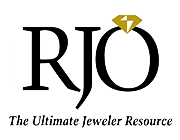Using your head when setting up the showcase!
Rote is defined as a “fixed, habitual or mechanical procedure.” Basically, doing the same thing, over and over again, time after time until it is being done without thought.
Setting up the showcases in a jewelry store each day before opening can easily become a mechanical effort, done without thought in a mindless sort of way. Take the stuff out of the bins, place it in the showcase more or less like it was yesterday and lock up the case before you unlock the front door. Easy enough, but is the lack of conscious thought costing you sales? It is very likely that it is.
The culprit in this lost opportunity is the lack of that “conscious thought.” Good visual merchandising is the implementation of purposeful conscious thought in organizing a display. If it is true that good displays sell more merchandise (and they do!), then it follows that bad displays sell less. Successful jewelers have an intention to their showcase layouts. They are thought through and the daily setup has been altered so that “setting up the showcases in the right way” is the new rote.
Here are a series of easy steps you can take to make sure your displays don’t fall into a same-o, same-o sub-par presentation that diminishes your sales.
Think Presentation!- Change your mindset from “getting it all into the showcase, to presenting the jewelry”. Jewelry is a precious thing filled with emotion, bought with anticipation and excitement. Don’t display it like socks. Make it look special. It is better (and far more profitable) to display 50 rings in a case very attractively, than to display 100 rings in that case poorly. A common mistake is thinking you are offering a big selection. You are, but you are demeaning the perceived value of what you are showing. Get some understock trays for the extra goods and pull out the backstock when the sales conversation warrants. Think presentation, not cram!
Clean up!- Do a thorough housecleaning. One great thing about bright lights in a showcase is that it illuminates the jewelry. Unfortunately, it also shines a spotlight on that makeup smear on that neckform and the raw fabric edge on the platform you banged against the case edge last year. People do notice these things that you might not even see anymore. Clean your displays with products like “Simple Green” and K2R spot remover. Vacuum out the showcases. Clean the inside of the glass. Toss any displays that have outlived their stay. Rewrap any old floorboards that are soiled. Odds are you would not wear a shirt that had an obvious big stain or tear in your store for your customers to see. Why let your displays look dirty?
See what they see!- Be sure you can see all the jewelry from the customer’s perspective. Have someone stand on the customer’s side of the showcases and confirm that all the goods are visible. Sometimes things like signs, big props and oversized neckforms can hide adjacent pieces in a case. Don’t play hide and seek with your merchandise.
Reduce distractions and clutter- Imagine how difficult it would be to work at your jewelers bench if it had to also contain flowers, signs, seashells, ceramic angels and Holiday decorations in addition to your tools? Well, your showcases are selling “platforms” that should contain what you need to do the task at hand. Get rid of the non-essential items unless they have a purpose in helping you sell and present your merchandise. Effective props and signs that communicate selling points should stay, but determine if the “other stuff” is helping or distracting.
De-color your world- As more vendors offer complimentary displays with their lines, the number of colors in some showcases has multiplied to rainbow proportions. All these colors have turned some stores into looking like a box of crayons. Consumers are accustomed to thinking color means something. (Think red lights and yellow crosswalks). Try to reduce the number of colors in your showcases to a minimum. Shoot for a maximum of 3 (unless it is a case full of boutique displays or watch platforms.) Then make the colors you do show mean something. Remember, the only role of the displays is to present and help sell the merchandise. This is a lot easier to do when showcase colors are few and in the background supporting the beautiful jewelry.
What do you want me to buy?- Show the pieces you want most to sell in a different manner. The more people that see a piece, the better the odds are someone might buy it. Place it on a small sign or display of some type. Place it near the back center of the showcase as that is the “sweet spot” where most people will look. Obvious point that shouldn’t need repeating… replace it with a new featured piece when it sells.
Too much is too much- Don’t overload the elements with multiple pieces. Putting 5 necklaces on a single neckform not only diminishes the beauty of the pieces, it keeps your staff from showing the pieces to clients. They will not want to do the work involved in putting the piece back on the neck, so they will avoid taking it out. It is very hard to convince me that this piece is very “special” when it is on a display with 35 other items. Nicer pieces deserve to be on individual displays.
Avoid “running on empty”- The absolute worst sign you can have in a showcases is one on a ring plug that says “Sold.” When you place sold tags in a tray to mark an empty slot, you convey the idea to your customer that your goods are picked over. A 12 ring tray with 4 sold tags in it says the best 1/3 of the selection is gone. Put the same remaining 8 rings in an 8 ring tray and instantly, you have a “full selection.” Keep some trays in reserve to allow your presentation to adjust to your inventory. Note to self… if it sold once, maybe I can sell another one if I reorder a replacement!
With competitive pressures coming at independent retailers from all sides, success depends heavily on conscious planning and execution. The customer has too many other shopping options to allow us to be lax. Stepping up the quality of your presentation is one of the first steps to take in maintaining and growing your business. If you can establish the practice of applying these good display ideas to your showcases on a regular basis, soon they will become the habit and the daily practice of setting up the store in the proper way, will become your new norm.




